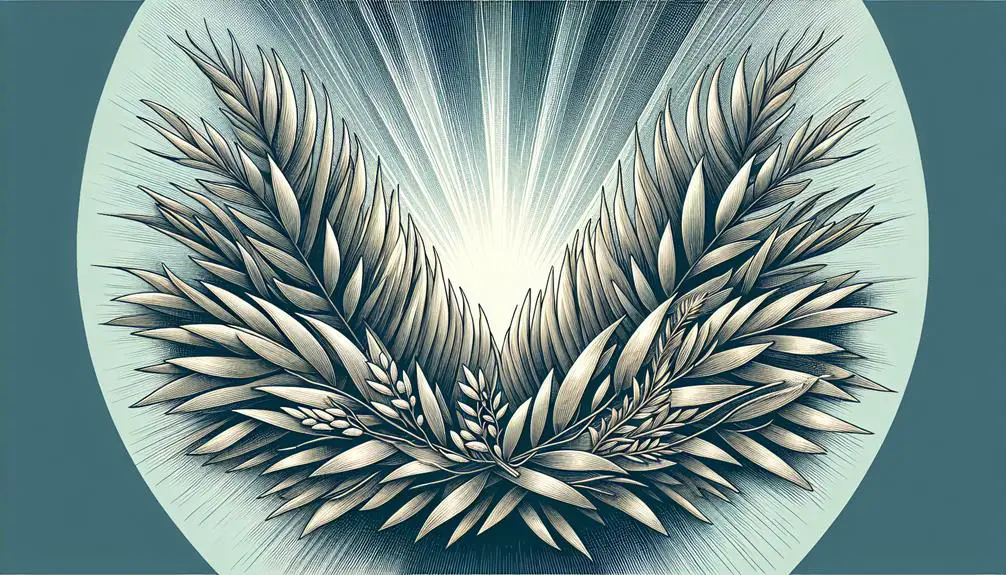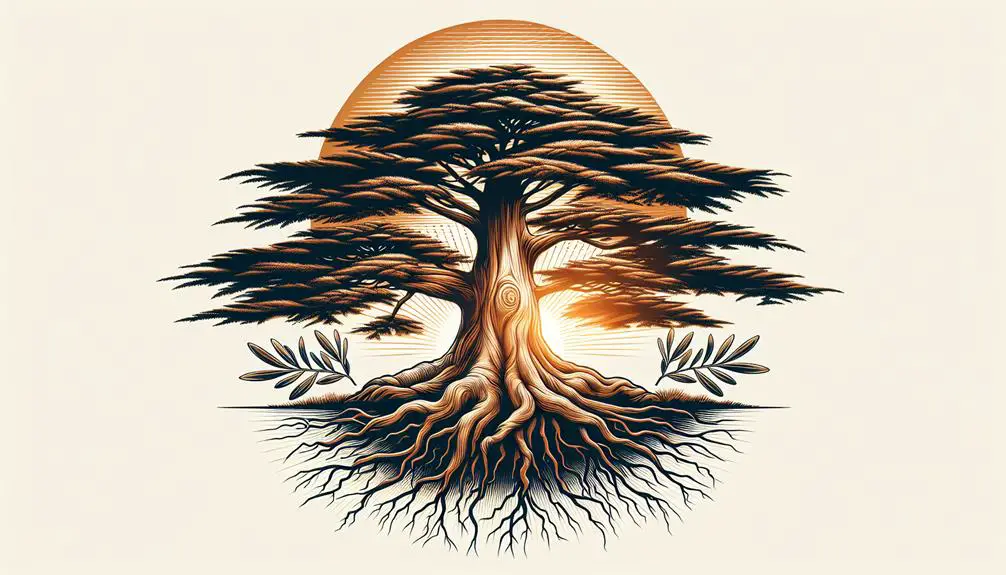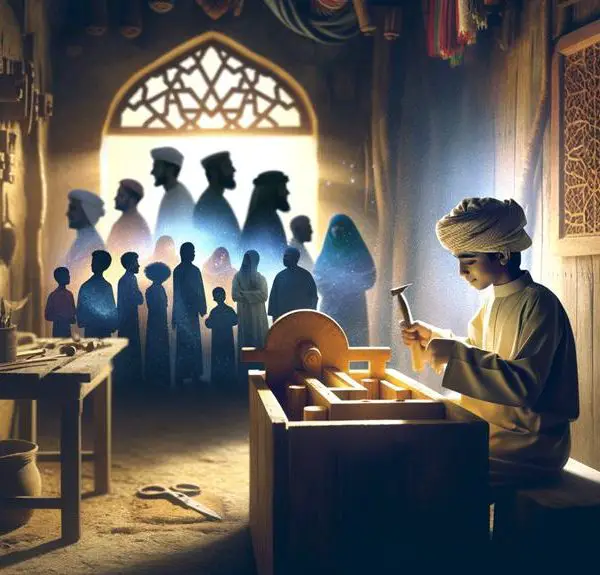Leaves in the Bible symbolize everything from shame to salvation; discover their deeper meanings and the mysteries they unfold.

Leaves Symbolism in the Bible
Have you ever considered how a simple leaf carries profound symbolism throughout the Bible? From the fig leaves Adam and Eve sewed together in a moment of shame to the palms waved in triumphant victory, each leaf tells a story of human experience, divine interaction, and spiritual lessons.
But that's just the surface. To truly grasp the depth of these symbols, you'll need to explore how olive branches speak of reconciliation and cedars symbolize strength. More intriguingly, the prophecy of leaves for the healing of nations offers a glimpse into a future hope that beckons further exploration.
What might these symbols reveal about the nature of faith and redemption?
Key Takeaways
- Fig leaves represent human shame and the futile attempt to hide sin.
- Palm branches and olive branches symbolize victory, peace, and reconciliation.
- Cedars signify enduring strength and faith through life's challenges.
- Leaves promise healing and global harmony in the biblical narrative.
The Fig Leaves of Shame

In the narrative of Genesis, the fig leaves represent not merely a primitive garment but a profound symbol of shame and the human attempt to conceal sin. After Adam and Eve commit the Original Sin by disobeying God's command not to eat from the Tree of Knowledge, their immediate reaction is one of self-awareness and embarrassment. They notice their nakedness for the first time, prompting them to sew fig leaves together as makeshift coverings. This act signifies more than an attempt to hide physical nudity; it marks the dawn of human consciousness of moral fault and the instinct to hide one's imperfections from the divine gaze.
The choice of fig leaves is particularly telling. In biblical times, fig leaves were large, easily accessible, and thus practical for immediate coverage. However, their quick wilting mirrors the frailty and temporary nature of human solutions to spiritual problems. Adam and Eve's use of fig leaves underscores a deeper narrative about the human condition: the futility of trying to cover up wrongdoing on our own. It highlights the inherent human desire to conceal sin, a theme that resonates throughout biblical text and human history.
Palms of Victory and Peace

Throughout biblical scripture, palm branches emerge as powerful symbols of victory and peace, representing triumphs both spiritual and temporal. This imagery isn't merely decorative but carries deep theological and cultural significance, encapsulating key themes of redemption, deliverance, and divine favor.
The ceremonial uses of palm branches are multifaceted, reflecting their importance in ancient rites and celebrations. Here are three notable aspects:
- Processional Symbol: Palms were often used in processions, especially those celebrating victories. This practice symbolizes the communal acknowledgment of triumph, with the branches acting as tangible signs of joy and success.
- Symbolic Offering: In various ceremonies, palms served as offerings, symbolizing the participants' dedication and thanksgiving for divine providence. This use underscores the intertwining of religious devotion and the acknowledgment of divine sovereignty in achieving victory.
- Liturgical Decor: During significant religious festivals, palms were used to decorate sacred spaces, signifying the sanctity of the occasion and invoking divine blessing. This decorative use enhances the spiritual atmosphere, connecting participants more deeply with the event's triumph imagery.
Analyzing these uses reveals how deeply embedded palms are in the fabric of biblical symbolism, serving as enduring emblems of victory and peace.
Olive Branches of Reconciliation

Just as palm branches symbolize victory and peace, olive branches carry their own profound biblical significance, representing reconciliation and the restoration of relationships. This symbol emerges most vividly in the story of Noah's dove returning with an olive branch, a sign that the floodwaters were receding and that God was restoring peace with humanity. This moment encapsulates the olive branch's role as a mediator of peace and a harbinger of new beginnings.
The use of olive branches extends beyond this narrative, intertwining with the practice of offering peace offerings in ancient rituals. These offerings, often accompanied by olive oil or branches, weren't merely ceremonial. They embodied the aspirational return to harmony between individuals and between humanity and the divine. In this context, the olive branch transcends its physical form, becoming a metaphor for the pursuit of reconciliation.
Analyzing the biblical text, you'll find that olive branches are more than botanical elements; they're deeply symbolic tools employed to convey themes of forgiveness, renewal, and the rebuilding of fractured bonds. This rich symbolism underscores the Bible's overarching message of hope and the potential for reconciliation in the face of estrangement and conflict.
Cedars: Strength and Endurance

Amid the rich tapestry of biblical symbolism, cedars stand as towering figures of strength and endurance, embodying the unwavering faith and resilience required to withstand life's tempests. These majestic trees aren't merely passive elements of the landscape; they actively contribute to the narrative of spiritual and physical fortitude.
Cedar construction, particularly in the context of sacred buildings, underscores the material's esteemed status. It symbolizes durability and permanence, qualities essential for structures meant to stand as houses of worship through the ages. The use of cedar in building projects is a testament to the value placed on materials that reflect divine attributes.
Symbolic plantings of cedars further enrich the narrative. These acts are:
- A declaration of faith in the future,
- A sign of reverence for the Creator's provision, and
- An expression of hope in the enduring nature of spiritual truths.
The cedar, thus, becomes more than just a tree; it's a living symbol of the strength and endurance that faith instills in believers. Through cedar construction and symbolic plantings, the biblical narrative weaves together themes of resilience, permanence, and the divine promise of strength to endure life's challenges.
Leaves for Healing Nations

In the biblical narrative, leaves serve as powerful symbols of healing and restoration for nations, reflecting a divine provision for both physical and spiritual maladies. This imagery, particularly vivid in the prophetic visions of Revelation, where the leaves of the tree of life are described as being for the healing of the nations, encapsulates a profound promise of eternal restoration. It's not just about the alleviation of immediate suffering; it's a foretaste of global harmony and the mending of deep-seated fractures between peoples and nations.
The symbolism extends beyond mere physical healing. It encompasses a holistic restoration where enmity, division, and strife are replaced with peace, unity, and understanding. This vision of leaves as agents of healing invites you to consider the broader, more inclusive perspective of divine intervention in human affairs. It suggests that the path to global harmony lies not only in addressing the symptoms of discord but in fostering an environment where the underlying causes of division can be healed.
Thus, the biblical motif of leaves for the healing of nations serves as a potent reminder of the promise of eternal restoration. It beckons you to view the pursuit of global harmony not as a utopian dream but as a tangible goal, anchored in the transformative power of divine grace.
Frequently Asked Questions
How Does the Symbolism of Leaves in the Bible Differ Between the Old and New Testaments?
In exploring how the symbolism of leaves shifts between the Old and New Testaments, you'll find seasonal imagery playing a crucial role.
In the Old Testament, leaves often signify life cycles and divine interventions, reflecting a broader, more ancient understanding of nature's rhythms.
Moving to the New Testament, leaves transform into healing representations, symbolizing restoration and hope, particularly seen in Revelations where leaves are for the healing of nations, marking a profound evolution in symbolic meaning.
Are There Any Types of Leaves Mentioned in the Bible That Symbolize Temptation or Sin, Aside From the Fig Leaves?
You're exploring whether the Bible mentions any leaves, aside from fig leaves, as metaphors for temptation or sin. While fig leaves famously represent shame and sin following Adam and Eve's disobedience, the text doesn't explicitly highlight other leaves in this specific context.
However, throughout Scripture, various plant imagery, including thorns and thistles, symbolizes sin and the curse of a fallen world, echoing the consequences of human actions. Leaf metaphors, though not always direct, enrich biblical sin representation.
How Do Biblical Scholars Interpret the Absence or Presence of Leaves in Parables and Stories Within the Bible?
You're delving into how biblical scholars interpret leaf metaphors and seasonal imagery in parables and stories. They often view the absence or presence of leaves as rich in symbolic meaning, reflecting themes like rebirth, mortality, and divine judgment.
Through an analytical lens, scholars suggest that these elements aren't just decorative but are insightful, offering deep reflections on human nature and divine principles. It's a fascinating approach that uncovers layers of meaning in biblical narratives.
In What Ways Do Leaves Play a Role in Biblical Prophecies or Visions of the Future?
Imagine trees whispering secrets of the future, their leaves turning with tales untold. In biblical prophecies, these leaves aren't just foliage; they're symbols of life's ebb and flow.
Leaf longevity and seasonal imagery paint vivid pictures of time's passage and divine plans. Analyzing these elements, you'll find leaves in visions often hint at renewal or judgment, offering a layered, insightful look into how the future is portrayed through nature's cycle.
Can the Symbolism of Leaves in the Bible Be Connected to Any Specific Rituals or Practices Observed by Ancient Israelites?
You'll find that leaf motifs do indeed intertwine with rituals and practices of ancient Israelites, especially during harvest celebrations.
These motifs aren't just decorative; they carry deep symbolic meaning, representing renewal, fertility, and life's cyclical nature.
In analyzing these practices, it's clear that leaves were more than mere foliage; they were integral to expressing gratitude and hope for future prosperity, embedding a rich layer of spiritual significance into these communal events.
Conclusion
In navigating the verdant paths of biblical symbolism, you've encountered leaves not as mere foliage but as profound symbols—fig leaves whispering of human shame, palms heralding victory and peace, olive branches weaving tales of reconciliation, and cedars embodying strength.
Like leaves dancing in the wind, these symbols reveal the intricate relationship between nature and divine message, offering a lens to view the moral and spiritual lessons embedded within.
Thus, leaves serve not only as nature's breath but also as a divine whisper, healing nations and guiding souls towards enlightenment.



Sign up